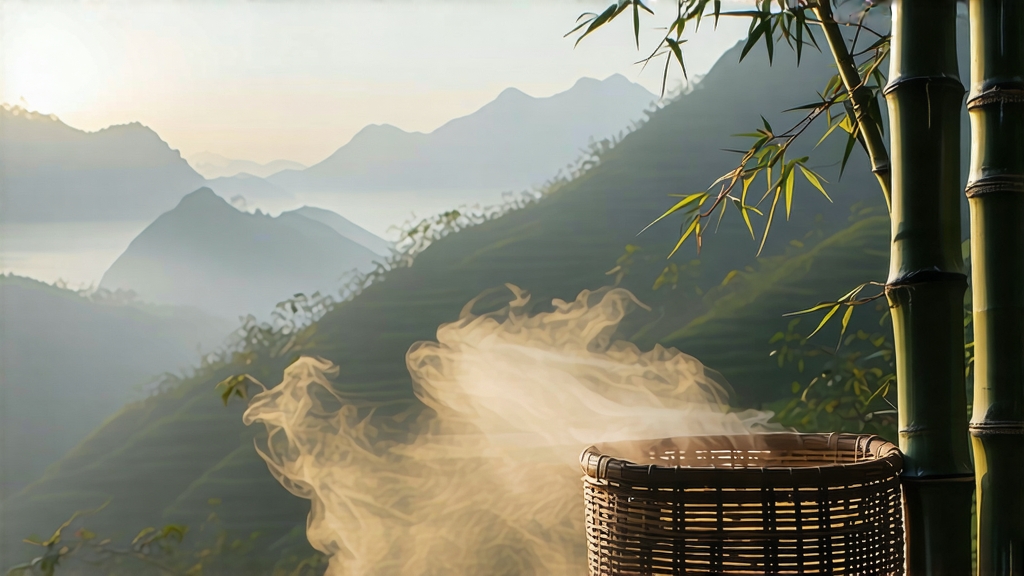
Tucked high on the mist-laden northern ridge of the Sichuan Basin, the Meng Ding mountain range has been sending fragrant tea caravans down the Min River for more than twelve centuries. Among the gifts that left these slopes was a tea so delicate that Tang-dynasty poets called it “the liquid moon of Shu.” Today international markets still know it by the same name that once graced imperial tribute lists: Meng Ding Huang Ya, Meng Ding Yellow Bud.
Although yellow tea is the smallest and most endangered of China’s six great tea families, Meng Ding Huang Ya has always acted as its charismatic ambassador. To understand why, one must follow the leaf from monastery legends to microscopic enzymatic chemistry, then finally into the cup, where a soft, sweet glow announces that something ancient and rare has survived.
-
Historical echoes
Buddhist monks began planting tea on Meng Ding as early as 742 CE, when the An Lushan rebellion cut northern trade routes and Sichuan became China’s cultural refuge. The court in Chang’an, desperate for luxury goods, accepted the first “yellow buds” as tribute in 820 CE. By Song times the emperor’s own tea office specified that only buds picked before the Qingming festival, while morning dew still held them closed, could be carried to the capital. During Ming and Qing, the tea disappeared from common commerce; the entire harvest belonged to the throne, and wild rumors claimed that pickers were forbidden to speak while working lest breath disturb the leaf. When the last dynasty collapsed in 1911, the technique almost vanished—farmers switched to faster-paying green teas—until 1959, when a state-sponsored restoration project rediscovered three octogenarian artisans who still remembered the secret “men huang” (sealed yellowing) step. Their knowledge became the blueprint for the modern Protected Geographical Indication (PGI) enacted in 2007, which today limits genuine Meng Ding Huang Ya to 2,300 mu (153 hectares) of certified gardens between 800 m and 1,400 m elevation. -
Micro-terroir
The range traps the Sichuan fog in a perpetual cloud belt 200 m thick. Photosynthetic rates drop, amino acids—especially L-theanine—accumulate, and catechins remain gentle. Mean annual temperature is 14.7 °C; diurnal swing can reach 15 °C, coaxing slow growth. Soils are yellow-brown lateritic loam, slightly acidic (pH 4.9–5.4), rich in kaolin that stores moisture yet drains quickly. These conditions yield an unusually high ratio of bud to leaf: one kilo of finished tea needs roughly 42,000 downy tips. -
Plucking code
The harvest window opens only ten days, from around March 20 to March 30, when two criteria coincide: the bud reaches 25 mm yet remains unopened, and the ambient humidity stays above 85 %. Teams of experienced women work barefoot to feel soil temperature; they pinch, never pull, placing each bud into a bamboo tube lined with fresh banana leaf to prevent compression heating. Picking stops at 10 a.m., when mountain clouds lift and solar radiation intensifies. -
Craft: the five breaths
Meng Ding Huang Ya is made by a sequence nicknamed “five breaths” because each step allows the leaf to inhale and exhale a little more oxygen than the last, edging it toward the yellow spectrum without ever crossing into black tea territory.
a. Sha Qing (Kill-Green) – 80 °C on bronze woks
Within 30 minutes of plucking, buds are tossed by hand for 3–4 minutes. The goal is to halt oxidative enzymes while preserving a core humidity of 62 %. The bronze, preferred over iron, radiates gentler heat and adds trace cupric ions that sharpen later aromatics.
b. Re Xian (Hot-Line Rolling) – silk cloth cylinders
While still at 50 °C, the buds are rolled under minimal pressure for 8 minutes to create micro-fissures; cell rupture is kept below 15 % so that polyphenol oxidase survives for the next critical step.
c. Men Huang (Sealed Yellowing) – the soul of yellow tea
The buds are piled 15 cm deep inside bamboo steamers, covered with wet hemp cloth, then slid into a cave-like room kept at 28 °C and 85 % humidity for 48–72 hours. During this time, endogenous peroxidases convert chlorophyll into pheoph